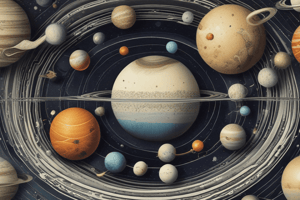Podcast
Questions and Answers
The Sun is the smallest object in the solar system.
The Sun is the smallest object in the solar system.
False (B)
Pluto is still considered a planet in the solar system.
Pluto is still considered a planet in the solar system.
False (B)
Earth has plate tectonics and an ozone layer that helps support life.
Earth has plate tectonics and an ozone layer that helps support life.
True (A)
Mars has a thick atmosphere mainly composed of oxygen.
Mars has a thick atmosphere mainly composed of oxygen.
There are 9 planets in the solar system.
There are 9 planets in the solar system.
Jupiter has four moons named Europa, Ganymede, Callisto, and Titan.
Jupiter has four moons named Europa, Ganymede, Callisto, and Titan.
Saturn's equator is significantly pronounced due to its high density.
Saturn's equator is significantly pronounced due to its high density.
Uranus rotates in a retrograde motion like Venus.
Uranus rotates in a retrograde motion like Venus.
Neptune is the closest planet to the Sun.
Neptune is the closest planet to the Sun.
Dwarf planets like Ceres and Pluto exist in the asteroid belt and Kuiper Belt.
Dwarf planets like Ceres and Pluto exist in the asteroid belt and Kuiper Belt.
Flashcards are hidden until you start studying
Study Notes
-
The solar system consists of planets and astronomical objects connected by the gravitational force produced by the central star, the Sun.
-
The Sun is the largest and most massive object in the solar system, with a diameter of 1.4 x 10^6 km and a mass of 2 x 10^30 kg.
-
The solar system is approximately 4.568 billion years old and is located within the Milky Way galaxy.
-
There are 8 planets in the solar system classified as inner planets (Mercury, Venus, Earth, Mars) and outer planets (Jupiter, Saturn, Uranus, Neptune).
-
The inner planets are rocky and small, while the outer planets are gas giants that formed in regions where matter quickly condensed into ice.
-
Pluto was reclassified as a dwarf planet in 2006 due to its lack of orbital dominance among other criteria for being classified as a planet.
-
Key characteristics of some planets:
- Mercury: Indications of shrinking surface and synchronicity between rotation and translation.
- Venus: Intense greenhouse effect leading to extreme temperatures, thick carbon dioxide atmosphere, and slow rotation.
- Earth: Supports life with protective ozone layer, abundant liquid water, plate tectonics, and diverse environments.
- Mars: Red color due to iron oxides, thin atmosphere mainly of carbon dioxide, evidence of past water presence, and Olympus Mons as a prominent feature.
- Jupiter: Giant gas planet with a rich atmosphere, the Great Red Spot storm, no solid ground, a core of heavy elements, strong magnetic field, and numerous natural satellites.- Jupiter has four large Galilean moons: Io, Europa, Callisto, and Ganymede, with the latter being the largest moon in the solar system.
-
These moons are fascinating worlds with features like water presence, volcanism, extreme weather, and magnetism.
-
Saturn's most distinctive feature is its complex ring system, composed of millions of ice particles, possibly remnants of ancient moons and comets.
-
Saturn's equator is significantly pronounced due to its low density and rotational motion, making it a flattened spheroid that could hypothetically float in a massive ocean.
-
Uranus exhibits retrograde rotation like Venus, with a greatly tilted rotation axis resulting in extreme seasons lasting 21 years.
-
Uranus' blue-green color comes from methane in its atmosphere, and it has a unique magnetosphere despite not producing metallic hydrogen.
-
Neptune, the farthest planet from the Sun, has a methane-rich atmosphere, a faint ring system similar to Uranus, and about 15 known moons, including Triton and Nereid.
-
Dwarf planets like Ceres, Pluto, Eris, Makemake, and Haumea exist in the asteroid belt and Kuiper Belt, distinct from traditional planets due to size and gravitational criteria.
-
The solar system contains over 100 moons orbiting the giant planets and three around inner planets like Earth's Moon and Mars' Phobos and Deimos.
-
Comets are icy bodies found in the outer solar system, originating from the cloud of matter that formed the solar system.
-
Asteroids, centaurs, and meteoroids are rocky fragments of varying sizes found between rocky and gas planets, exhibiting characteristics of asteroids and comets.
Studying That Suits You
Use AI to generate personalized quizzes and flashcards to suit your learning preferences.




